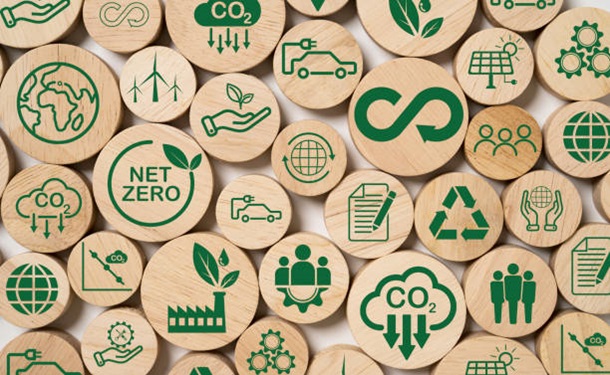Impediments of Green Finance Adoption System: Linking Economy and Environment

Downloads
Doi:10.28991/ESJ-2022-06-02-02
Full Text:PDF
Downloads
Wang, L., Vo, X. V., Shahbaz, M., & Ak, A. (2020). Globalization and carbon emissions: Is there any role of agriculture value-added, financial development, and natural resource rent in the aftermath of COP21? Journal of Environmental Management, 268, 110712. doi:10.1016/j.jenvman.2020.110712.
Christmann, P., & Taylor, G. (2017). Globalization and the environment: Strategies for international voluntary environmental initiatives. Corporate Environmental Responsibility, 563–577. doi:10.4324/9781315259277-30.
Zhang, D., Zhang, Z., & Managi, S. (2019). A bibliometric analysis on green finance: Current status, development, and future directions. Finance Research Letters, 29, 425–430. doi:10.1016/j.frl.2019.02.003.
Egli, F., Schärer, D., & Steffen, B. (2022). Determinants of fossil fuel divestment in European pension funds. Ecological Economics, 191. doi:10.1016/j.ecolecon.2021.107237.
Sachs, J. D., Woo, W. T., Yoshino, N., & Taghizadeh-Hesary, F. (2019). Importance of Green Finance for Achieving Sustainable Development Goals and Energy Security. Handbook of Green Finance (pp. 3–12). doi:10.1007/978-981-13-0227-5_13.
Tol, R. S. J. (2018). The economic impacts of climate change. Review of Environmental Economics and Policy, 12(1), 4–25. doi:10.1093/reep/rex027.
Yanarella, E. J., Levine, R. S., & Lancaster, R. W. (2009). Green versus sustainability. Sustainability, 2(5), 296–302. doi:10.1089/SUS.2009.9838.
Chowdhury, T. U., Datta, R., & Mohajan, H. K. (2013). Green finance is essential for economic development and sustainability. International Journal of Research in Commerce, 3(10), 104–108.
Ahmad, M., Ahmed, Z., Yang, X., Hussain, N., & Sinha, A. (2021). Financial development and environmental degradation: Do human capital and institutional quality make a difference? In Gondwana Research. doi:10.1016/j.gr.2021.09.012.
Fu, J., & Ng, A. W. (2020). Sustainable energy and green finance for a low-carbon economy: Perspectives from the greater bay area of China. In Sustainable Energy and Green Finance for a Low-carbon Economy: Perspectives from the Greater Bay Area of China. Springer International Publishing. doi:10.1007/978-3-030-35411-4.
Zafar, S. S., Fiaz, M., Ikram, A., Khan, K. I., & Qamar, U. M. (2021). Barriers involve in the energy efficiency in the manufacturing industries of Pakistan. International Journal of Energy Economics and Policy, 11(2), 293–299. doi:10.32479/ijeep.7599.
Monasterolo, I., Roventini, A., & Foxon, T. J. (2019). Uncertainty of climate policies and implications for economics and finance: An evolutionary economics approach. Ecological Economics, 163, 177–182. doi:10.1016/j.ecolecon.2019.05.012.
Falcone, P. M., & Sica, E. (2019). Assessing the opportunities and challenges of green finance in Italy: An analysis of the biomass production sector. Sustainability (Switzerland), 11(2), 517. doi:10.3390/su11020517.
Yoshino, N., Schloesser, T., & Taghizadeh-Hesary, F. (2021). Social funding of green financing: An application of distributed ledger technologies. International Journal of Finance and Economics, 26(4), 6060–6073. doi:10.1002/ijfe.2108.
Rjoub, H., Odugbesan, J. A., Adebayo, T. S., & Wong, W. K. (2021). Sustainability of the moderating role of financial development in the determinants of environmental degradation: Evidence from turkey. Sustainability (Switzerland), 13(4), 1–18. doi:10.3390/su13041844.
Liu, N., Liu, C., Xia, Y., Ren, Y., & Liang, J. (2020). Examining the coordination between green finance and green economy aiming for sustainable development: A case study of China. Sustainability (Switzerland), 12(9), 3717. doi:10.3390/su12093717.
Cui, Y., Geobey, S., Weber, O., & Lin, H. (2018). The impact of green lending on credit risk in China. Sustainability (Switzerland), 10(6), 2008. doi:10.3390/su10062008.
Taghizadeh-Hesary, F., & Yoshino, N. (2019). The way to induce private participation in green finance and investment. Finance Research Letters, 31, 98–103. doi:10.1016/j.frl.2019.04.016.
Qin, J., Zhao, Y., & Xia, L. (2018). Carbon emission reduction with capital constraint under greening financing and cost sharing contract. International Journal of Environmental Research and Public Health, 15(4), 750. doi:10.3390/ijerph15040750.
Tolliver, C., Fujii, H., Keeley, A. R., & Managi, S. (2021). Green Innovation and Finance in Asia. Asian Economic Policy Review, 16(1), 67–87. doi:10.1111/aepr.12320.
Cui, X., Zhao, T., & Wang, J. (2021). Allocation of carbon emission quotas in China's provincial power sector based on entropy method and ZSG-DEA. Journal of Cleaner Production, 284. doi:10.1016/j.jclepro.2020.124683.
He, L., Liu, R., Zhong, Z., Wang, D., & Xia, Y. (2019). Can green financial development promote renewable energy investment efficiency? A consideration of bank credit. Renewable Energy, 143, 974–984. doi:10.1016/j.renene.2019.05.059.
Boubaker, S., Nguyen, D. K., Berensmann, K., & Lindenberg, N. Green Finance: Across the Universe. Corporate Social Responsibility, Ethics and Sustainable Prosperity, 305–332. doi.org/10.1142/9789811206887_0011
Soundarrajan, P., & Vivek, N. (2016). Green finance for sustainable green economic growth in India. Agricultural Economics (Czech Republic), 62(1), 35–44. doi:10.17221/174/2014-AGRICECON.
D'Orazio, P., & Popoyan, L. (2019). Fostering green investments and tackling climate-related financial risks: Which role for macroprudential policies? Ecological Economics, 160, 25–37. doi:10.1016/j.ecolecon.2019.01.029.
Durrani, A., Rosmin, M., & Volz, U. (2020). The role of central banks in scaling up sustainable finance–what do monetary authorities in the Asia-Pacific region think? Journal of Sustainable Finance and Investment, 10(2), 92–112. doi:10.1080/20430795.2020.1715095.
Kamran, H. W., Haseeb, M., Nguyen, T. T., & Nguyen, V. C. (2020). Climate change and bank stability: The moderating role of green financing and renewable energy consumption in ASEAN. doi:10.31219/osf.io/v48fa.
Kirikkaleli, D., & Adebayo, T. S. (2021). Do renewable energy consumption and financial development matter for environmental sustainability? New global evidence. Sustainable Development, 29(4), 583–594. doi:10.1002/sd.2159.
Bieliński, T., & Mosionek-Schweda, M. (2018). Green bonds as a financial instrument for environmental projects funding. Unia Europejska. pl, 248(1), 13-21.
Azhgaliyeva, D. (2019). Energy storage and renewable energy deployment: Empirical evidence from OECD countries. Energy Procedia, 158, 3647-3651. doi.org/10.1016/j.egypro.2019.01.897.
Volz, U., Böhnke, J., Eidt, V., Knierim, L., Richert, K., & Roeber, G.-M. (2015). Financing the Green Transformation ” Market Failures, Government Failures and the Role of the State. Financing the Green Transformation, 7–21. doi:10.1057/9781137486127_2.
Jha, N., & Bhome, S. (2013). A study of green banking trends in India. International Monthly Referred Journal of Research in Management and Technology, 2, 127-132.
Wang, Y., & Zhi, Q. (2016). The role of green finance in environmental protection: Two aspects of market mechanism and policies. Energy Procedia, 104, 311-316. doi.org/10.1016/j.egypro.2016.12.053.
Peng, H., Luo, X., & Zhou, C. (2018). Introduction to China's Green Finance System. Journal of Service Science and Management, 11(01), 94–100. doi:10.4236/jssm.2018.111009.
Haleem, A., Sushil, Qadri, M. A., & Kumar, S. (2012). Analysis of critical success factors of world-class manufacturing practices: An application of interpretative structural modelling and interpretative ranking process. Production Planning and Control, 23(10–11), 722–734. doi:10.1080/09537287.2011.642134.
Dowson, M., Poole, A., Harrison, D., & Susman, G. (2012). Domestic UK retrofit challenge: Barriers, incentives and current performance leading into the Green Deal. Energy Policy, 50, 294–305. doi:10.1016/j.enpol.2012.07.019.
Lee, J. H., & Woo, J. (2020). Green new deal policy of South Korea: Policy innovation for a sustainability transition. Sustainability (Switzerland), 12(23), 1–17. doi:10.3390/su122310191.
Zubair Mumtaz, D. M., & Alexander Smith, D. Z. (2019). Green Finance for Sustainable Development in Pakistan. IPRI Journal, 2, 1–34. doi:10.31945/iprij.190201.
Charles, G., & Philip, B. (2020). Green Finance: Recent Drifts, Confrontation and Prospect Opportunities for Sustainable Development in India. Mukt Shabd Journal, 9(4), 1854–1865.
Khan, K. I., Babar, Z., Sharif, S., Iqbal, S., & Khan, M. I. (2021). Going green? Investigating the role of GSCM practices on firm financial and environmental performance through green innovation. International Journal of Procurement Management, 14(6), 681–701. doi:10.1504/IJPM.2021.117894.
Mohd, S., & Kaushal, V. K. (2018). Green Finance: A Step towards Sustainable Development. MUDRA : Journal of Finance and Accounting, 5(1), 59–74. doi:10.17492/mudra.v5i01.13036.
Guild, J. (2020). The political and institutional constraints on green finance in Indonesia. Journal of Sustainable Finance and Investment, 10(2), 157–170. doi:10.1080/20430795.2019.1706312.
Runhaar, H., Tigchelaar, C., & Vermeulen, W. J. V. (2008). Environmental leaders: Making a difference. A typology of environmental leaders and recommendations for a differentiated policy approach. Business Strategy and the Environment, 17(3), 160–178. doi:10.1002/bse.520.
Ren, X., Shao, Q., & Zhong, R. (2020). Nexus between green finance, non-fossil energy use, and carbon intensity: Empirical evidence from China based on a vector error correction model. Journal of Cleaner Production, 277, 122844. doi:10.1016/j.jclepro.2020.122844.
Soedarmono, W., Machrouh, F., & Tarazi, A. (2011). Bank market power, economic growth and financial stability: Evidence from Asian banks. Journal of Asian Economics, 22(6), 460–470. doi:10.1016/j.asieco.2011.08.003.
Gupta, H., & Barua, M. K. (2018). A framework to overcome barriers to green innovation in SMEs using BWM and Fuzzy TOPSIS. Science of the Total Environment, 633, 122–139. doi:10.1016/j.scitotenv.2018.03.173.
Banga, J. (2019). The green bond market: a potential source of climate finance for developing countries. Journal of Sustainable Finance and Investment, 9(1), 17–32. doi:10.1080/20430795.2018.1498617.
Ghisetti, C., Mancinelli, S., Mazzanti, M., & Zoli, M. (2017). Financial barriers and environmental innovations: evidence from EU manufacturing firms. Climate Policy, 17, S131–S147. doi:10.1080/14693062.2016.1242057.
Frederick, W. C. (1997). Financing change: The financial community, eco-efficiency, and sustainable development. The Journal of Socio-Economics, 26(4), 459–463. doi:10.1016/s1053-5357(97)90007-x.
Petruzzelli, A. M., Dangelico, R. M., Rotolo, D., & Albino, V. (2011). Organizational factors and technological features in the development of green innovations: Evidence from patent analysis. Innovation: Management, Policy and Practice, 13(3). doi:10.5172/impp.2011.13.3.291.
Matus, K. J. M., Xiao, X., & Zimmerman, J. B. (2012). Green chemistry and green engineering in China: Drivers, policies and barriers to innovation. Journal of Cleaner Production, 32, 193–203. doi:10.1016/j.jclepro.2012.03.033.
Abuzeinab, A., Arif, M., & Qadri, M. A. (2017). Barriers to MNEs green business models in the UK construction sector: An ISM analysis. Journal of Cleaner Production, 160, 27–37. doi:10.1016/j.jclepro.2017.01.003.
Zubair Mumtaz, D. M., & Alexander Smith, D. Z. (2019). Green Finance for Sustainable Development in Pakistan. IPRI Journal, 2, 1–34. doi:10.31945/iprij.190201.
Rahman, T., Ali, S. M., Moktadir, M. A., & Kusi-Sarpong, S. (2020). Evaluating barriers to implementing green supply chain management: An example from an emerging economy. Production Planning and Control, 31(8), 673–698. doi:10.1080/09537287.2019.1674939.
Choi, C. (2009). Removing Market Barriers to Green Development: Principles and Action Projects to Promote Widespread Adoption of Green Development Practices. Journal of Sustainable Real Estate, 1(1), 107–138. doi:10.1080/10835547.2009.12091785.
Samari, M., Godrati, N., Esmaeilifar, R., Olfat, P., & Shafiei, M. W. M. (2013). The investigation of the barriers in developing green building in Malaysia. Modern Applied Science, 7(2), 1–10. doi:10.5539/mas.v7n2p1.
Nguyen, T. C., Chuc, A. T., & Dang, L. N. (2019). Green Finance in Viet Nam. In Handbook of Green Finance (pp. 675–705). doi:10.1007/978-981-13-0227-5_35.
Yoshino, N., Taghizadeh-Hesary, F., & Nakahigashi, M. (2019). Modelling the social funding and spill-over tax for addressing the green energy financing gap. Economic Modelling, 77, 34–41. doi:10.1016/j.econmod.2018.11.018.
Sareen, A., & Sharma, S. (2021). Assessing Financial Distress and Predicting Stock Prices of Automotive Sector: Robustness of Altman Z-score. Vision: The Journal of Business Perspective, 097226292199092. doi:10.1177/0972262921990923.
Nag, R., & Gioia, D. A. (2012). From common to uncommon knowledge: Foundations of firm-specific use of knowledge as a resource. Academy of Management Journal, 55(2), 421–457. doi:10.5465/amj.2008.0352.
Gioia, D. A., Corley, K. G., & Hamilton, A. L. (2013). Seeking Qualitative Rigor in Inductive Research: Notes on the Gioia Methodology. Organizational Research Methods, 16(1), 15–31. doi:10.1177/1094428112452151.
Nath, V., Kumar, R., Agrawal, R., Gautam, A., & Sharma, V. (2014). Impediments to Adoption of Green Products: An ISM Analysis. Journal of Promotion Management, 20(5), 501–520. doi:10.1080/10496491.2014.946200.
Gholami, H., Rezaei, G., Saman, M. Z. M., Sharif, S., & Zakuan, N. (2016). State-of-the-art Green HRM System: Sustainability in the sports center in Malaysia using a multi-methods approach and opportunities for future research. Journal of Cleaner Production, 124, 142–163. doi:10.1016/j.jclepro.2016.02.105.
Makki, A. A., Alidrisi, H., Iqbal, A., & Al-Sasi, B. O. (2020). Barriers to Green Entrepreneurship: An ISM-Based Investigation. Journal of Risk and Financial Management, 13(11), 249. doi:10.3390/jrfm13110249.
Mojumder, A., & Singh, A. (2021). An exploratory study of the adaptation of green supply chain management in construction industry: The case of Indian Construction Companies. Journal of Cleaner Production, 295, 295. doi:10.1016/j.jclepro.2021.126400.
Sarkar, A., Qian, L., Peau, A. K., & Shahriar, S. (2021). Modeling drivers for successful adoption of green business: an interpretive structural modeling approach. Environmental Science and Pollution Research, 28(1), 1077–1096. doi:10.1007/s11356-020-10490-z.
Mathiyazhagan, K., Govindan, K., NoorulHaq, A., & Geng, Y. (2013). An ISM approach for the barrier analysis in implementing green supply chain management. Journal of Cleaner Production, 47, 283–297. doi:10.1016/j.jclepro.2012.10.042.
Awuzie, B. O., & Abuzeinab, A. (2019). Modelling organisational factors influencing sustainable development implementation performance in higher education institutions: An interpretative structural modelling (ISM) approach. Sustainability (Switzerland), 11(16), 4312. doi:10.3390/su11164312.
Priya, S. S., Priya, M. S., Jain, V., & Dixit, S. K. (2021). An assessment of government measures in combatting COVID-19 using ISM and DEMATEL modelling. Benchmarking. doi:10.1108/BIJ-05-2021-0244.
Stireman, J. O., Dyer, L. A., Janzen, D. H., Singer, M. S., Lill, J. T., Marquis, R. J., Ricklefs, R. E., Gentry, G. L., Hallwachs, W., Coley, P. D., Barone, J. A., Greeney, H. F., Connahs, H., Barbosa, P., Morais, H. C., & Diniz, I. R. (2005). Climatic unpredictability and parasitism of caterpillars: Implications of global warming. Proceedings of the National Academy of Sciences of the United States of America, 102(48), 17384–17387. doi:10.1073/pnas.0508839102.
Rosales, J. (2008). Economic growth, climate change, biodiversity loss: Distributive justice for the global north and south. Conservation Biology, 22(6), 1409–1417. doi:10.1111/j.1523-1739.2008.01091.x.
Fankhauser, S., & Tol, R. S. J. (2005). On climate change and economic growth. Resource and Energy Economics, 27(1), 1–17. doi:10.1016/j.reseneeco.2004.03.003.
Raut, R. D., Narkhede, B., & Gardas, B. B. (2017). To identify the critical success factors of sustainable supply chain management practices in the context of oil and gas industries: ISM approach. Renewable and Sustainable Energy Reviews, 68, 33–47. doi:10.1016/j.rser.2016.09.067.
- This work (including HTML and PDF Files) is licensed under a Creative Commons Attribution 4.0 International License.


















